Delicious chicken stew mixed with belt-wide hand-pulled noodles, Big Plate Chicken (Da Pan Ji) is a warming & hearty crowd pleaser and lots of fun to make.

As many of you know, I was born and raised in the northwest of China where Muslim halal restaurants are very popular. Today’s recipe, Big Plate Chicken with Belt Noodles, is one of the classic dishes from that region. This post includes three parts: detailed cooking tips covering every aspect of the dish; a printable recipe card & a tutorial video inside the card.
What is Big Plate Chicken
Big Plate Chicken is the literal translation of Da Pan Ji (大盘鸡), the Chinese name of the dish. It originated from Xinjiang, an autonomous region in the northwest of China. Local restaurants originally serving this dish gained popularity among lorry drivers who stopped for an all-in-one hearty meal. Overtime this warming, tasty dish started appearing on menus in restaurants from other regions of the country.
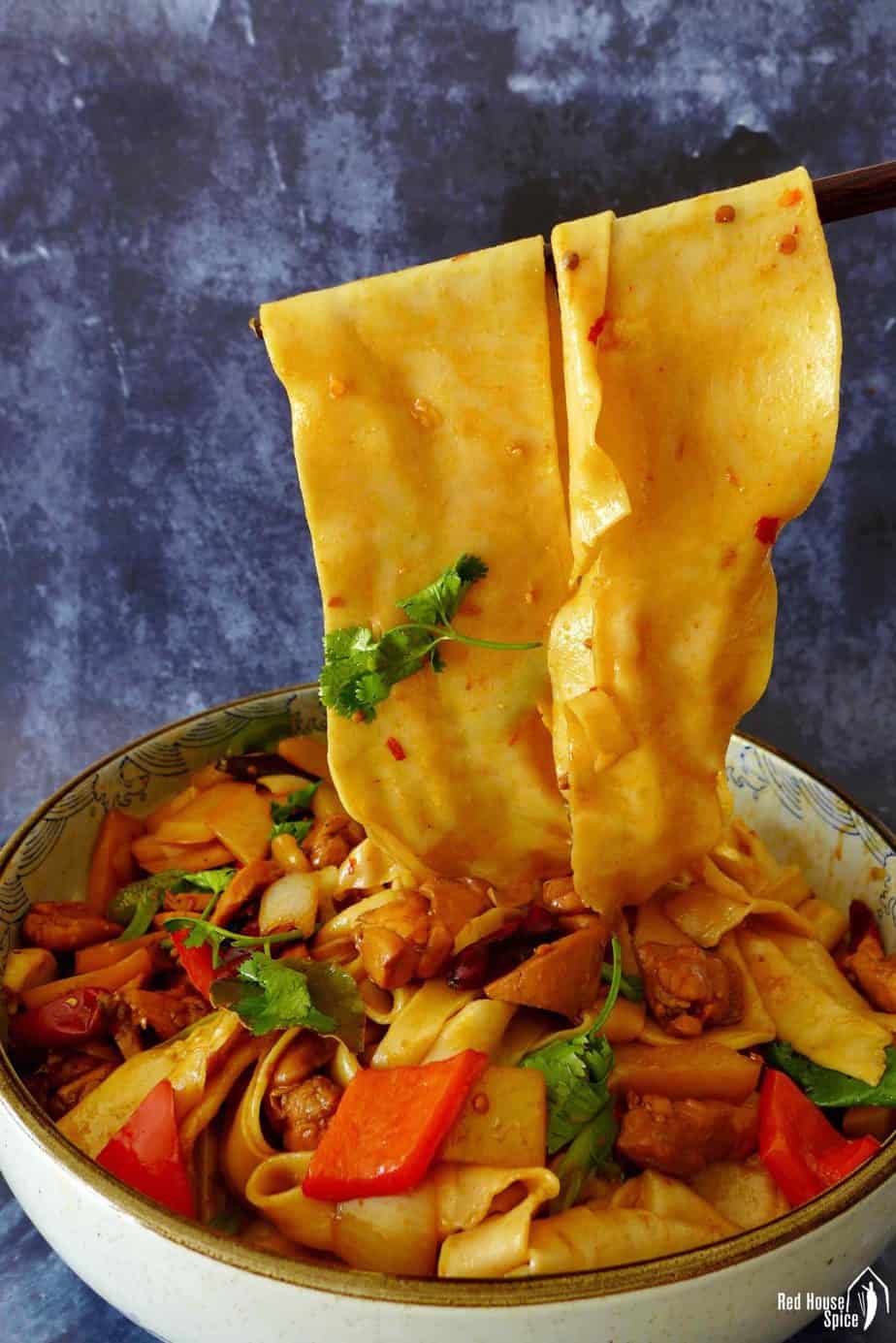
The dish consists of two elements: a spicy, aromatic chicken stew (with some vegetables) and hand-pulled noodles known as “belt noodles (皮带面)“ because of their super wide look (around 6cm/2inches).
A stress-free workflow
To save time and energy, it’s very important to have a good workflow when cooking Big Plate Chicken. Here are the procedures that I follow:
- Use flour, water and a little salt to prepare the dough. You may achieve this either by hand or with a stand mixer. Divide it into 6 parts. Coat thoroughly with oil, then leave to rest for an hour.
- While waiting for the dough to rest, cut the chicken and vegetables into chunks. Have all the spices and seasonings ready. About 20 minutes before the dough finishes resting, start cooking the chicken & vegetables.
- While waiting for the chicken to cook, bring a large pot of water to a full boil. Then start the noodle pulling and cooking process.
- Get a large plate or bowl. Lay belt noodles on the bottom then top with all the chicken and vegetables. Don’t forget to pour in any remaining juice as this will coat the noodles with great flavour.
How to cook the chicken
Which cut of chicken
Big Plate Chicken served in Chinese restaurants typically uses bite-size chicken pieces chopped from a whole chicken. They have skin on and bone in (Sometimes you would see a chicken head and chicken feet too).
My recipe has a much simpler approach: use skinless, boneless chicken thighs then cut them into chunks. Use other cuts of a chicken if you wish (chicken drums, wings). But I personally don’t recommend chicken breast as it’s rather plain in flavour and has a drier texture.
Season with great flavour
The ingredient list for seasoning the chicken is quite long. They are the key to creating an aromatic and bold flavour for the dish.
- Sichuan chilli bean paste (Doubanjiang/豆瓣酱, aka broad bean paste) has an earthy, aromatic, fermented tasty. It gives the dish a tangy kick. The best-known variety is Pixian Douban (郫县豆瓣, Pixian broad bean paste) which is available in most Chinese stores or online shopping platforms (I have other recipes which call for this paste. eg. Sichuan boiled beef, Mapo tofu).
- Ginger & garlic. Be generous. They taste great on their own after cooking in the broth.
- Spices: You would need star anise, cassia cinnamon (Chinese cinnamon), bay leaf, dried chilli, whole Sichuan peppercorn. You may skip one or two if not available.
- Dark soy sauce. It provides the saltiness and an appetizing brown look. My recipe doesn’t include salt as it’s salty enough for my liking. Add a little if you wish.
Add some vegetables
Three vegetables are used in classic Big Plate Chicken: Onion, pepper and potato. They contribute to taste, colour and texture. I personally love the potato more than the chicken in this dish! Cook it until a little mushy on the edge. It will soak up lots of flavour from the broth.
How to make perfect dough
An easy basic dough
Hand-pulling noodles may seem fascinating. The ingredients required are super simple. Wheat-based white flour, water and a little salt. That’s all! I usually use British all-purpose flour which has a medium gluten level (10-11% protein). It works really well. Please note that wholemeal flour/gluten-free flour is not suitable for making hand-pulled noodles.
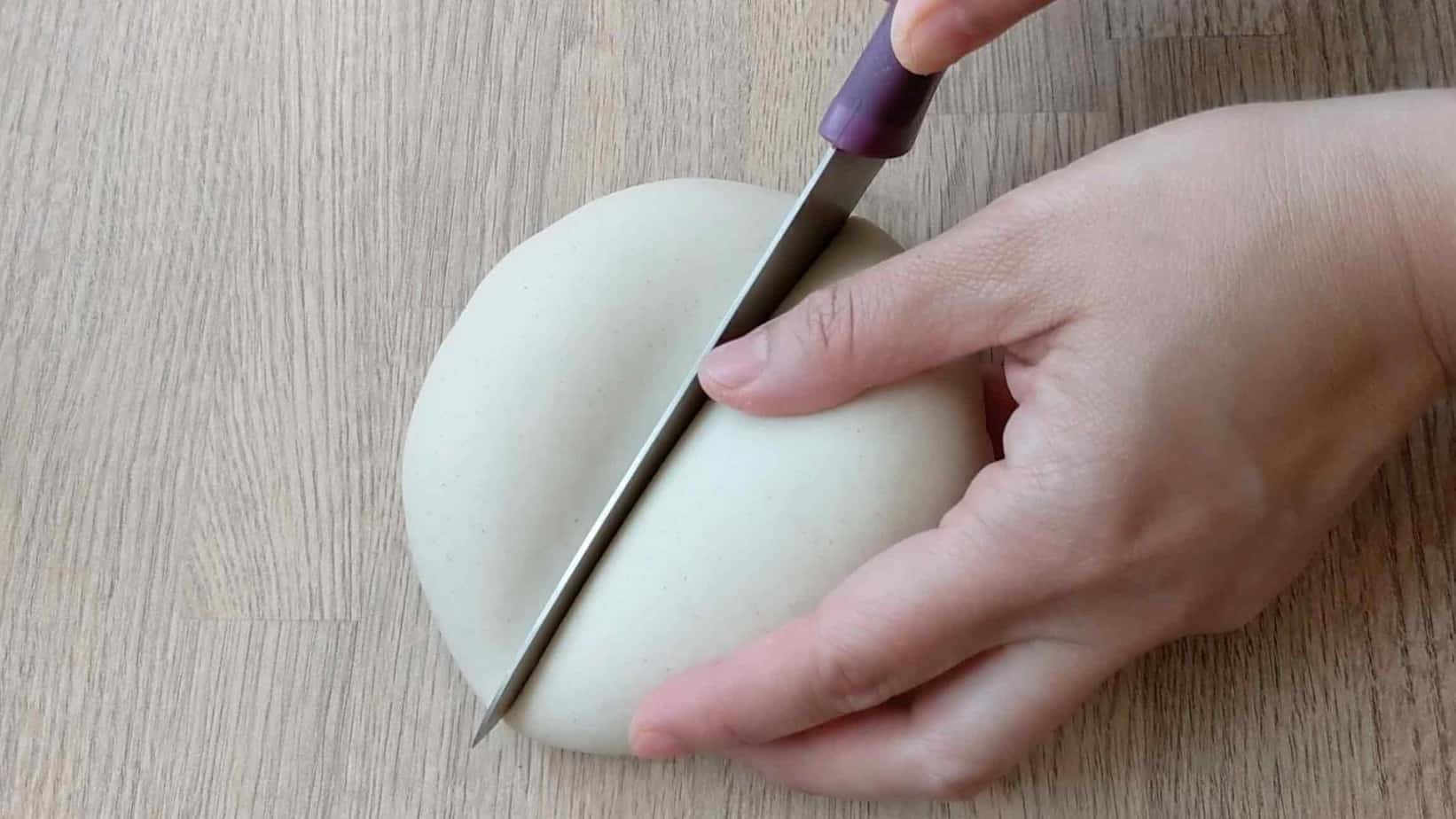
The flour-water ratio is 2:1 by WEIGHT. That is to say, for 300g flour, you would need 150g water (150ml). If unfamiliar with dough making, I strongly recommend you measure the ingredients using a kitchen scale (instead of measuring cups) as the result is much more accurate and consistent.
NB: Flour of different brands has slightly different water absorption capacity. You may need to reduce/increase the water volume a little to achieve the desired dough texture (watch my tutorial video below to see what it is like).
The importance of dough resting
Stage one: form a smooth dough. If you are kneading the dough by hand, here is a trick for making the dough super smooth: Firstly, combine the three ingredients into a dough ball. Leave it to rest for 10 minutes then knead again. It will take you only 2-3 minutes to get it smooth. At this stage, the dough should be medium firm.
If using a stand mixer with a dough hook, knead on low speed for about 8 mins (no resting needed)
Stage two: shape the dough then rest. For my recipe, I make six belt-wide noodles. So now you need to divide the dough into 6 equal parts. Roll each piece into a gherkin shape. Place them onto a plate. Coat each piece with cooking oil thoroughly. Cover with cling film then rest for 1-1.5 hours.
The resting process is crucial for making the dough super elastic & stretchy. As I quoted in my post on “Xi’an Biang Biang Noodles”:
From the moment you bring a liquid ingredient (such as milk or water) in contact with wheat flour, the individual gluten proteins in the flour unravel and hook onto one another, creating strong bonds. With time, an elaborate network of interconnected gluten strings forms…… It is the gluten network that holds a dough together and gives it elasticity and the ability to stretch.
——The Scientific Secret of Stretchy Dough, SCIENTIFIC AMERICAN
How to pull & cook the noodles
Pull the noodles with confidence
Soft and elastic, now the dough pieces are well-rested. It’s time to stretch them into belt-wide noodles! This is how you do it (Please refer to my tutorial video in the recipe card below):
- Flatten each dough piece into a thin, rectangle shape with a rolling pin.
- Pick up one piece of dough by holding each end gently. Pull in opposite directions. The movement should be smooth and consistent.
- As your arms move apart, bounce the noodle against the worktop to help it stretch further.
Cook the noodles at the same time
For hand-pulled noodles, the pulling and cooking happen simultaneously. When the water starts to boil, you pull the first noodle and drop it into the water. Then pull the second one and drop it in. Repeat until you finish all six pieces of dough. Leave to cook for 1-2 minutes then dish out. You need to act fast without hesitation. It’s not advised to leave pulled noodles on the worktop as they stick and loose shape easily.
NB: I’ve written a foolproof guide on “How to make hand-pulled noodles from scratch” which covers all aspects of this culinary art and techniques for making thinner noodles for other classic dishes. If you are new to this, it may be a good idea to start with the thinner version. Then move on to belt-wide noodles later on.
How to serve the dish
Now you have the two elements of the dish ready. As the name “Big Plate Chicken” suggests, you would need a large deep plate (or bowl) to serve. My bowl shown in the images measures 30cm/12inches in diameter. That’s the size of a big frying pan (BTW, why not serve it in a frying pan if your plate isn’t big enough).
Pour in the cooked belt noodles. Then top with the chicken and vegetables. Don’t forget to pour in all the delicious juice. It will give the noodles a glossy and tasty coating. Bring the whole dish to the table then stir around with great passion. Believe me! Everyone will love it and empty the whole plate.
A tip: When having Big Plate Chicken in Chinese restaurants, it’s very common that diners order extra portions of belt noodles. Increase the dough volume if you wish to do the same. However, if you don’t have time to make the noodles, serve the chicken with plain rice. It tastes great too!
How to make it in advance
The chicken and vegetables can be made in advance. Reheat in the wok before serving (In fact I find the flavour is even better next day).
Unlike other types of homemade fresh noodles (knife-cut, machine-made, etc.), hand-pulled noodles have a high content of water thus they stick easily. It’s impossible to store uncooked ones. There are two solutions though:
- Make the dough in advance. Divide into parts. Shape and coat with oil as instructed in my recipe. Keep in the fridge in an airtight container overnight. Bring it back to room temperature before pulling.
- Store cooked noodles. Pull and cook them as usual. Drain, then rinse under cold water until completely cool. Coat the noodles with a dash of sesame oil. Keep in the fridge overnight. Reheat in boiling water for about 1 min before serving.
That said, I strongly recommend you prepare the noodles on the day whenever possible. They taste best this way!
Other dishes to try
I have some other Northwest Chinese dishes on my blog. Check them out!
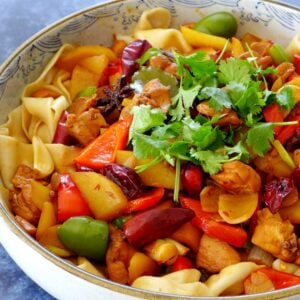
Big Plate Chicken with Belt Noodles (大盘鸡)
Ingredients
For the noodles
- 300 g all-purpose flour
- ¼ teaspoon salt
- 150 g water - see note 1
- cooking oil - for coating the dough
For the chicken
- 2 tablespoon cooking oil
- 800 g chicken thigh, cut in chunks
- 1½ tablespoon Sichuan chilli bean paste
- 10 slice ginger
- 10 clove garlic
- 3 star anise
- 2 piece cassia cinnamon
- 1 bay leaf
- 1 handful dried chilli - or to taste
- 1 tablespoon Sichuan pepper
- 1½ tablespoon dark soy sauce
For the vegetables
- 1 red bell pepper, cut in chunks
- 1 green bell pepper, cut in chunks
- 1 medium-sized potato, cut in thin pieces
- 1 onion, diced
- 3 stalks scallions, chopped
- coriander - optional
Instructions
Make & rest the dough (1 hour 15 mins)
- Mix flour and salt. Add water gradually. Mix with chopsticks until no more loose flour can be seen.
- Combine and knead briefly into a dough. Cover and leave to rest for 10 minutes. Knead again for about 2 minutes until very smooth (see note 2).
- Divide the dough into 6 parts. Roll each piece into a gherkin shape.
- Coat them with oil thoroughly. Cover with cling film then rest for at least 1 hour.
Cook the chicken & vegetables (20 mins)
- Heat up the oil in a wok. Stir in the chicken. Fry until pale.
- Add all the herbs, spices and seasonings for the chicken. Pour in 250ml (1 cup) hot water. Cover with a lid. Leave to cook for 10 mins.
- Put in bell pepper, potato and onion (add some hot water if appear to be dry). Stir around then leave to cook for a further 5 mins until the vegetables become tender. Add scallions at the end.
Pulled and cook the noodles (5 mins)
- When the dough is well rested, bring a large pot of water to a full boil.
- While waiting, use a rolling pin to flatten each dough piece into a rectangle shape.
- Pick up one piece by holding each end gently. Pull in opposite directions. The movement should be smooth and consistent.
- As your arms move apart, bounce the noodle against the worktop to help it stretch further (Please refer to the tutorial video below). Drop the pulled noodle into boiling water.
- Pull the second one and drop it in. Repeat until you finish all six pieces of dough. Leave to cook for 1-2 minutes (see note 3).
Assemble the dish
- Transfer the noodles to a large serving plate/bowl using a pair of chopsticks.
- Pour in the cooked chicken & vegetables.
- Garnish with coriander if using. Stir well & enjoy immediately.
Video
NOTES
NUTRITION
NUTRITION DISCLOSURE: Nutritional information on this website is provided as a courtesy to readers. It should be considered estimates. Please use your own brand nutritional values or your preferred nutrition calculator to double check against our estimates.



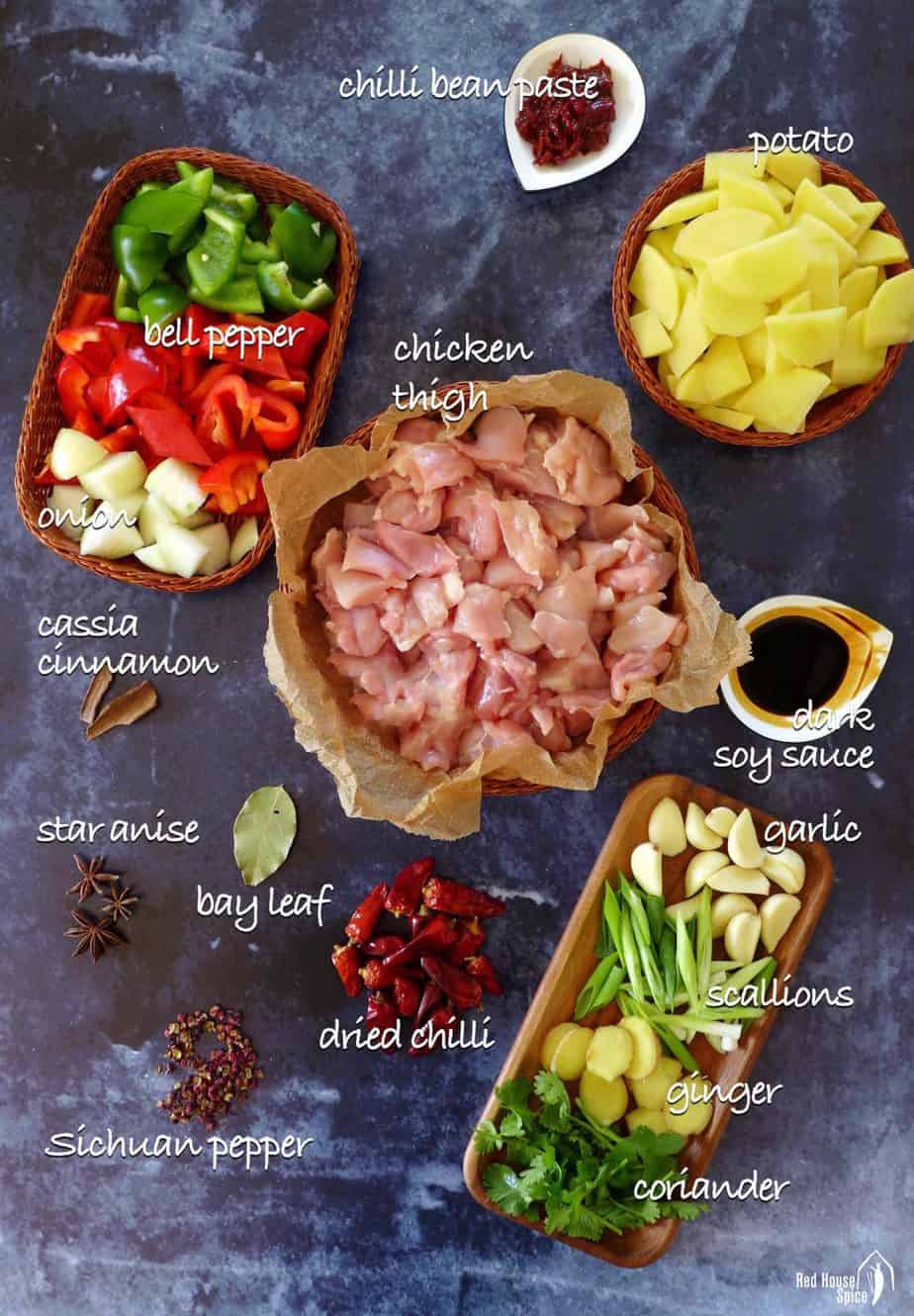
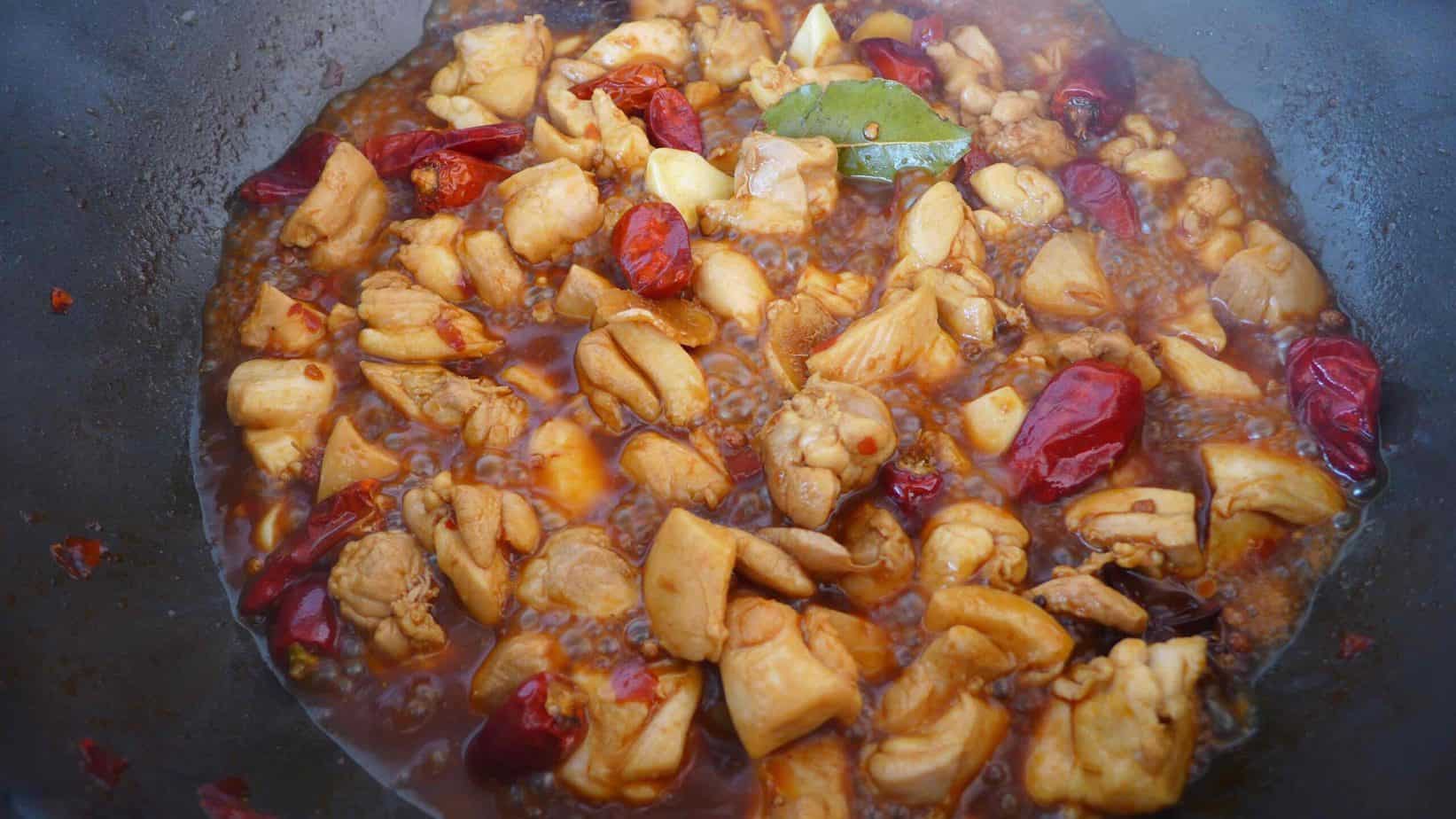

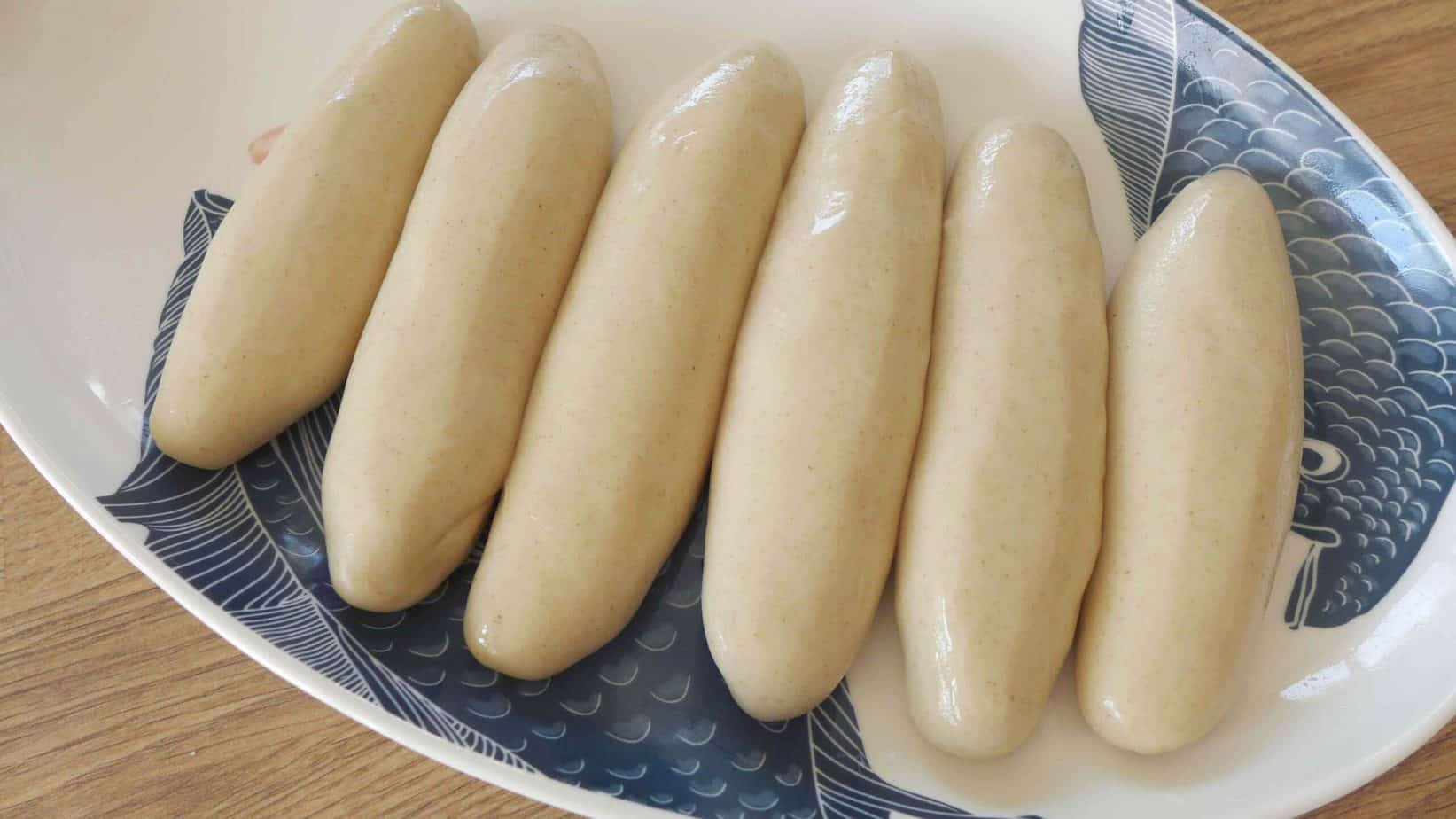

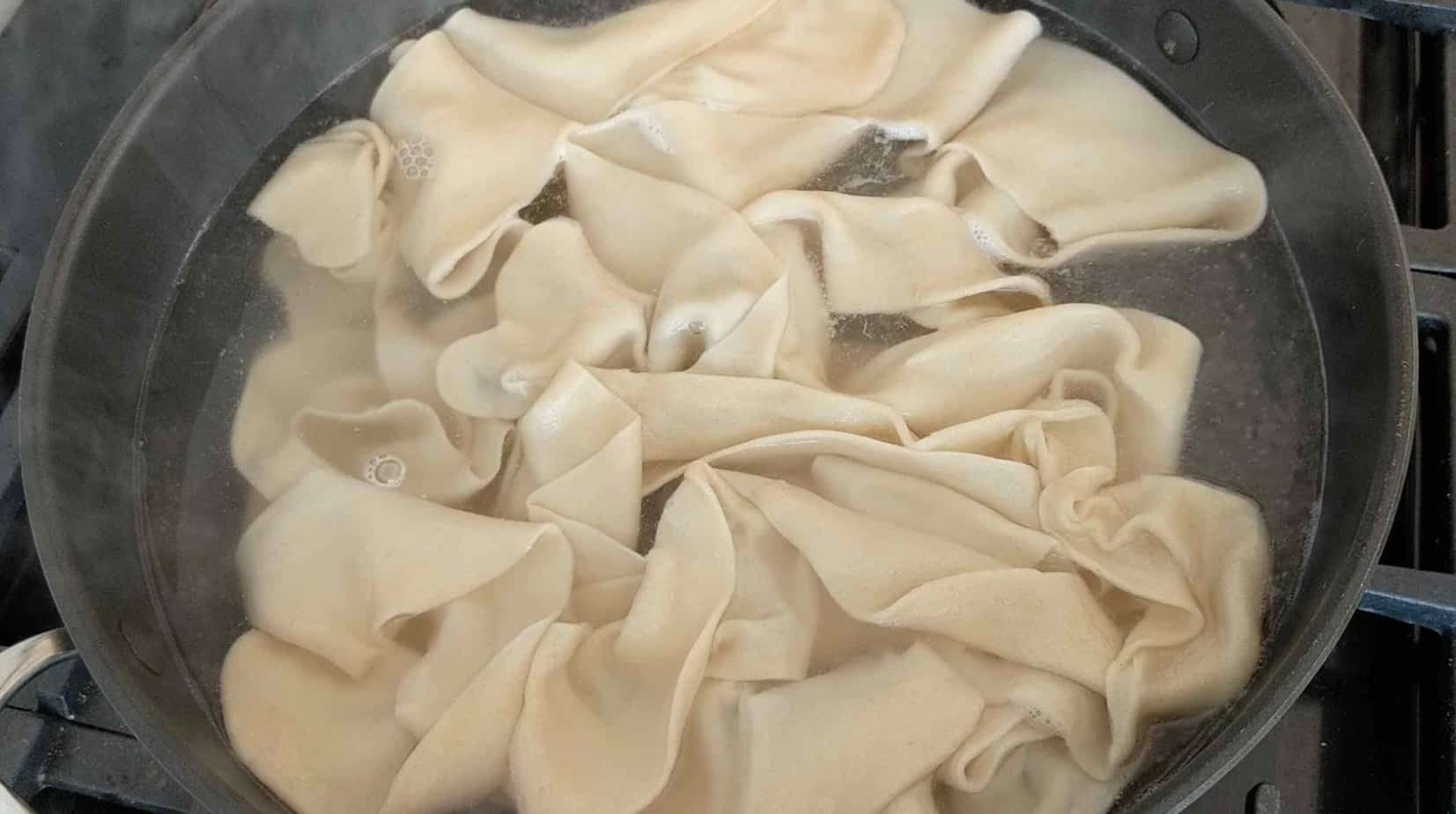
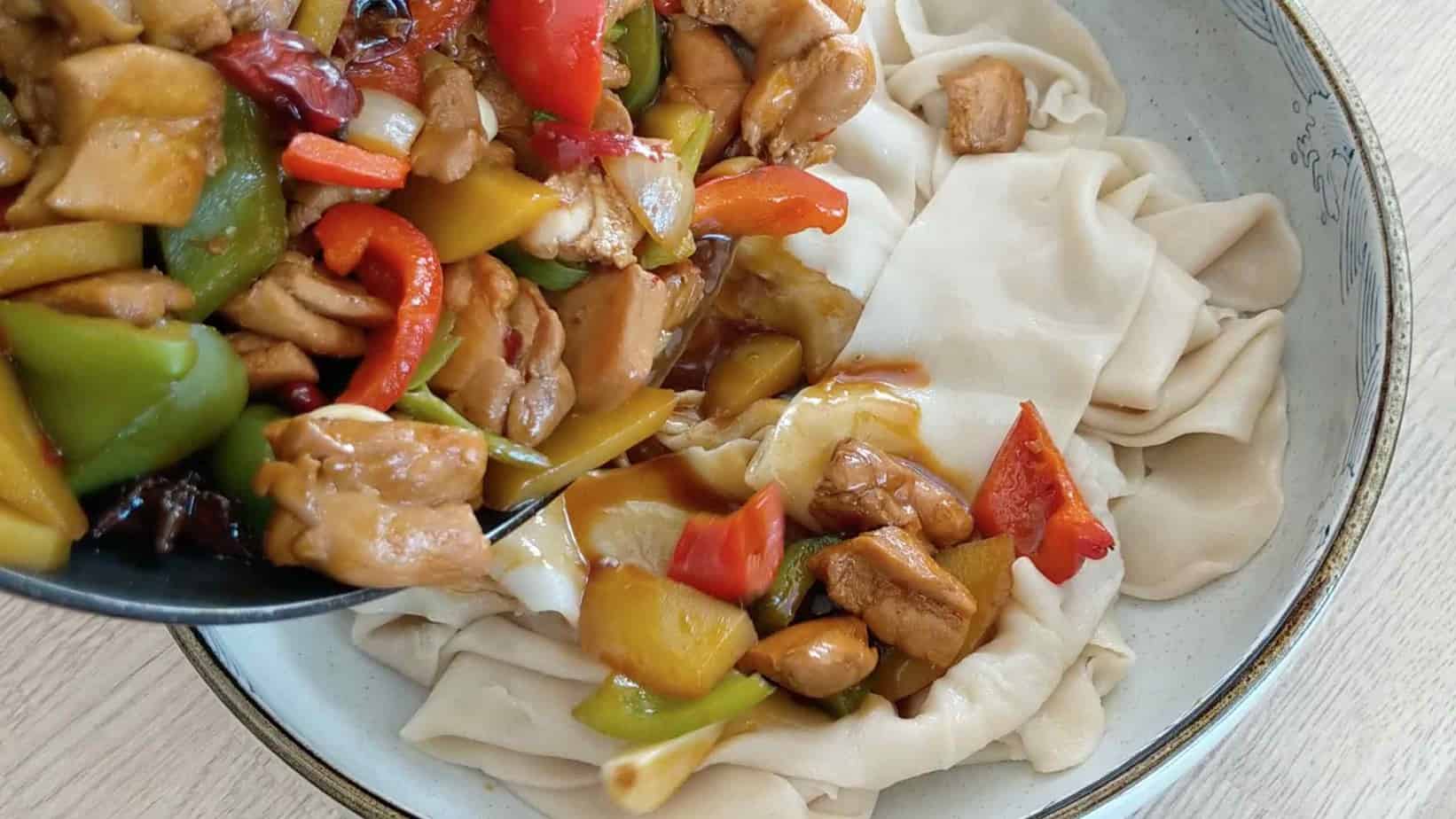
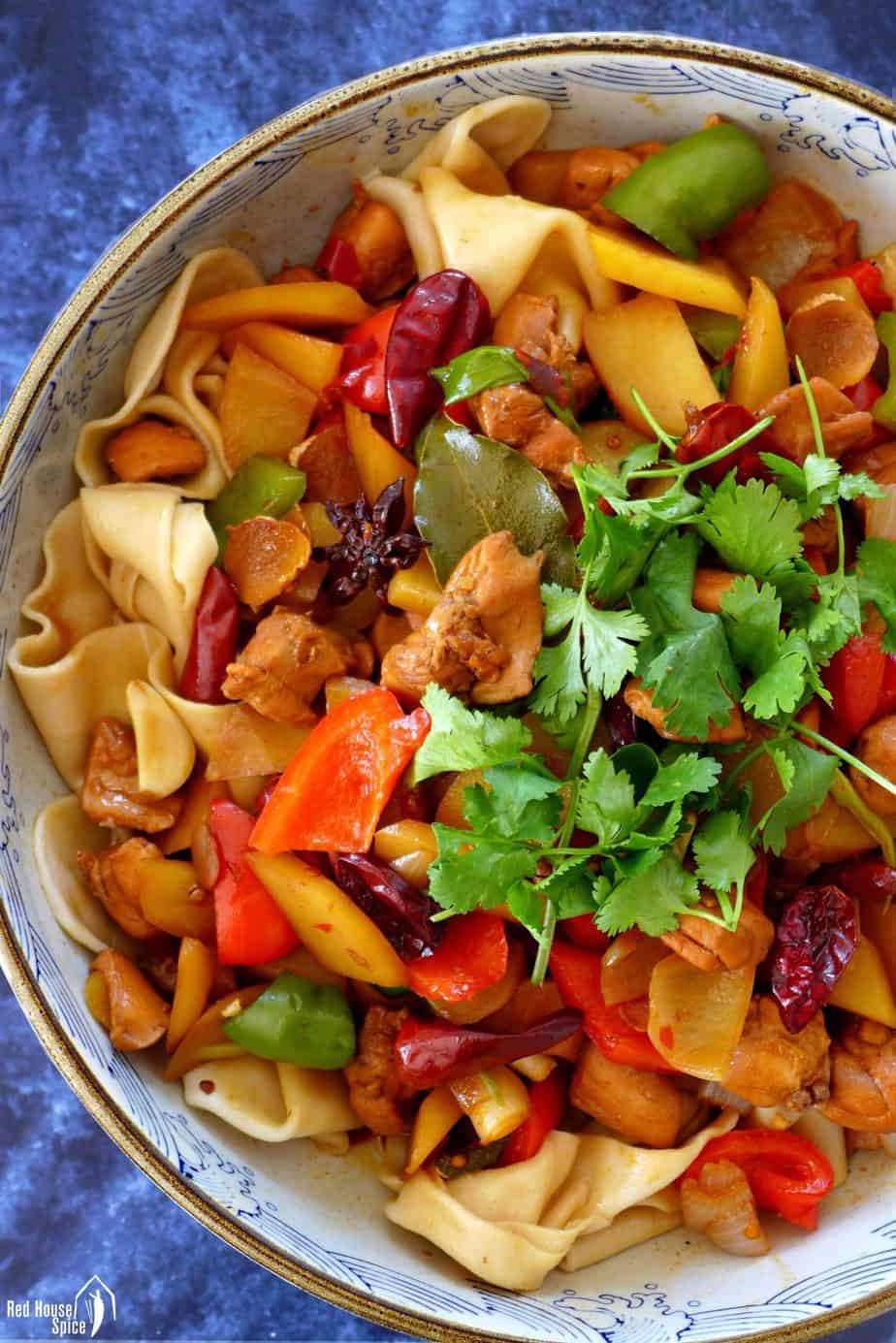
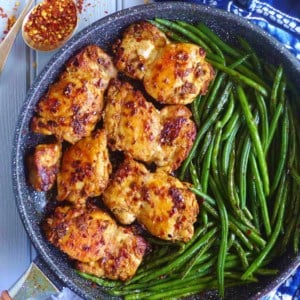
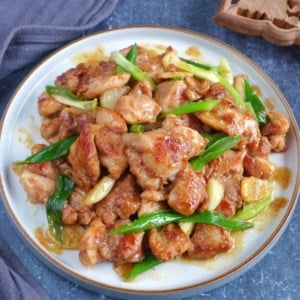
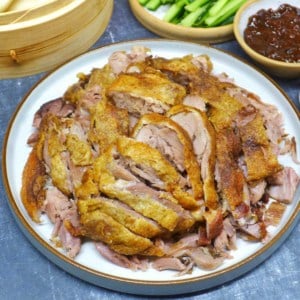

Super yummy!
. Made this last night for the family. They wolfed it down with my son having 3 helpings. Easy instructions to follow. The noodles I rolled out flat and cut, I’m too heavy handed to pull noodles.
That’s wonderful to hear! Your alternative noodle method sounds great. But try pulling the noodles the next time. It may be easier than you thought.
Hi Madame Wei! I’ve been to a chinese restaurant and take this dish. It was really good and spicy like I use to love, but il was parfume with cumin. I was waswondering if it was a traditionnal way to make it or if it’s a kind of variation on this dish. Thank you very much! And thank you for your recipes! They are awsome!!!
As I mentioned in the post, this is considered a Xinjiang dish (although created by a Sichuan chef). Cumin is a very popular spice in local Xinjiang cuisine (often paired with dried chili). So I’m not at all surprised to hear a variation with cumin.
HI..I just made this. My family all love it. It turned out well. I just need to practice with the noodle, so that all have similar thickness..but..i am quite proud of the result. Thank you for the recipe.
That’s wonderful to hear! I’m sure you’ll master the noodle skill very soon.
Another great dish. The flavor was complex and enjoyable. For my first time pulling noodles, I was surprised when they were just as chewy and tasty as the ones I remember from restaurants. Thank you!
My pleasure Jared! Glad that you’ve enjoyed it!
This is the second time I’ve made this. The stir fry is multi layered and delicious. This time I did the noodles too! What fun! The dough is gorgeous and easy to work with. I can’t wait to make more hand pulled noodles in the future. Thanks Wei!
You’re welcome Heather! Very happy to hear that you’ve enjoyed making and eating this dish. Wish you more fun pulling noodles in 2021!
Is there a way to make a vegetarian version of this dish?
Hi Sara! You could skip the chicken and increase the volume of the vegetables. Or, use pan-fried tofu to replace the chicken. It won’t be “big plate chicken” any more, but I’m sure it will still taste nice.
This dish was AMAZING! I didn’t pull my own noodles just because of time constraints, but the sauce was so flavorful! The whole family loved it!
So happy to hear that Tessa! Try making your own noodles next time when you’re not in a hurry!